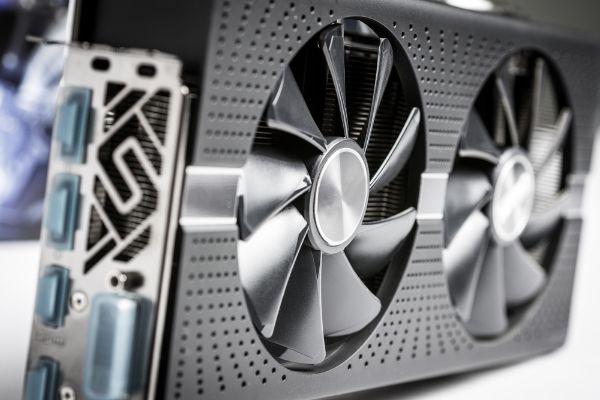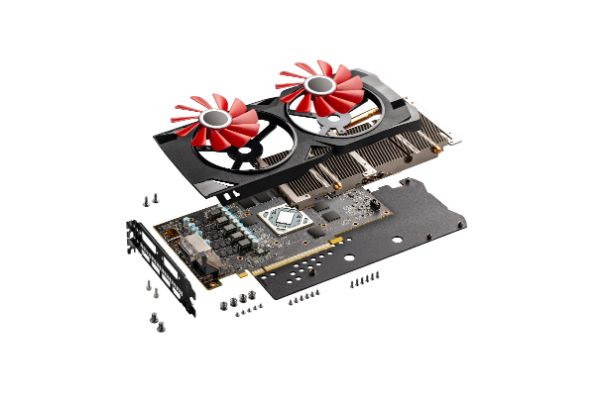Disclaimer: This post may contain affiliate links, meaning we get a small commission if you make a purchase through our links, at no cost to you. For more information, please visit our Disclaimer Page.
In computers and game consoles, the graphics processing unit is just as important as the central one. While many central processors can pull off some work with graphics these days, dedicated cards are still the way to go for resource-intensive applications. They help to display textures, improve frames, and generally work hard to make sure games and other kinds of apps can run smoothly and keep you in an immersive environment.
To do that, they get quite warm as they expend a lot of energy. Although other fans in a computer or console case are there to keep all the components as cool as possible, things like graphics processors usually have the addition of a fan of their own. Sometimes, GPU models may come with more than one fan.
Some users run into the problem of their graphics processor’s fans turning off and on several times repeatedly. Even though fans are supposed to ramp up their activity as the components they cool get hotter, it is not necessarily the norm for them to go from active to inactive in quick succession. Therefore, we will discuss why this might happen in our article below.
As we get into the topic, we’ll talk about whether any kinds of GPU fans might have design features for running continuously. Further, we will show you ways that you might check to make sure that your fans are working properly, and we will wrap up with a talk about fan speed changes, including what they could do to a GPU.
Table of Contents
Why Do My GPU Fans Keep Turning On and Off?
There are a few reasons why your graphics processor’s fans might turn on and off quickly. We can provide you with some of the most common causes here. For the most part, some fans have different modes that could cause them to run only at certain speeds or times. For example, your graphics processor may have a fan that has an active mode to reduce noise to nothing.
When you are running a heavy application that the GPU must work with, the fan may spin up and get loud in order to keep the component cool as heat builds up around it. While this is certainly useful, it can mean that the whole computer might get quite noisy for long periods. Manufacturers understand that this can be unpleasant, so many of them install modes for running with no noise, and this usually means stopping the fan.
Slowing or stopping the fan on a GPU should only happen when the component does not need to work hard. If the GPU isn’t ramping up how much heat it is producing, the fan that cools it does not need to be running much, if it does at all. When this happens, it could get quiet.
However, this very low threshold is something that assumes the processor will only do light work. If you are ramping up the intense activities you are doing on the computer, it means that the GPU may need to work harder quite suddenly. Should this be the case, it also means that the fan might come on and start running.
Once things go back to a state of light work, the fan will cycle down again. This could happen several times.
Similarly, different workloads produce different temperatures. Your fan for the graphics processor may have a low threshold for these temps. If your computer’s activities are right around whatever that line is, you may find that the fan spins up, cools it down to below that line, and stops again.
With the low threshold point, and this kind of activity may cause an increase that wakes the fan up. Should this work be light and quick, the fan will cool things down fast and stop, but it may start up again shortly. This is one of the main reasons why you might be dealing with a fan that turns itself on and off repeatedly.
Do GPU Fans Run All the Time?
Typically, a graphics processor’s fan should not need to run all the time. The settings on them make it so that they spin up whenever they might need to deal with heat concerns from the GPU itself.
It is possible that you could alter these settings yourself in order to make the fans run continuously. However, there should be little need to do this, and making the mechanical fans run constantly can shorten the life of the motor.
Similarly, you may encounter a situation in which your fan runs constantly even if you did not change the settings. Should this happen to you, it may indicate a problem with the fan itself. We will go over certain ways to check the GPU and its fans in the next section.
For now, it is important to understand fan curve.
This is a reference to the setting at which the fan spins up when the graphics processor is under load. If the curve is too low, the fan might spin at very low temperatures.
This is true even if the temperatures are so low that, technically, there is little need for the fan to be active. At this point, your computer would be wasting both power and the fan’s motor to cool a component that doesn’t need it at the moment.
One of the few other scenarios in which you might notice a graphics processor’s fan spinning constantly is if the card gets hot and stays that way. In this case, the fan will seem like it spins all the time, and it does this because the processor might be getting so hot that the cooling system is having trouble keeping up with the heat demands.
The fans should get quite loud during these times, so it would be easy for a player to notice the issue. Some games or other applications may require the GPU to work close to full capacity for some time. However, no processor should need to operate under a full load for a long time just to make the programs run effectively.
How Do I Check if My GPU Is Working Properly?
Making sure that your graphics processor is running as it should is key to making sure your computer stays healthy. When games experience an overload, it means the card cannot handle the data.
This often causes programs to shut down and go to the computer’s desktop. In more extreme cases, you may find that the whole system shuts the computer off. Either way, it is good to make sure that the GPU is working well enough to do its job.
One of the cursory ways you can do this is just to play a game or some other program that uses high resources. You may hear your fan spin up from time to time to cool down the processor. However, if everything seems to be running smoothly, and if the GPU does not read as using its full capacity for extended periods, there is little reason to think that anything is wrong with this component.
Should you want to go for a more in-depth, concrete look at the graphics processor, you can download various utility tools that will give you all the information you might ever need to know about your card. In many cases, you can set these programs up in such a way that they can provide you with clear readings of anything that might be amiss.
While we’re on the subject, it might be a good idea to look at the specific make and model of your GPU. The manufacturer may have data on what numbers are normal for that particular device.
Finally, you can also use an application that will put the card under a stress test and record the results. You can also do this by running any kind of detailed current or next-generation video game that requires a lot of resources from your graphics processor. If everything appears to be normal, you’re good to go. If there are any anomalies, your next move will depend on what is wrong with the card.
Can Changing Fan Speed Break a GPU Fan?
Changing the fan speed for the GPU’s cooling system should not break the fan. Before we go a bit deeper, we have to remember that it is a mechanical device at heart. Any mechanical thing can fail, so there is always that possibility.
However, we spoke already about fan curves, and we talked about how you can set a custom one in order to meet the needs of your graphics processor. Manufacturers will design most fans to be able to do this kind of thing without incident. If changing the fan speed results in a broken fan, it is possible that the motor or blades were already approaching some kind of failure scenario.
Conclusion
Graphics processors are essential to enjoying the latest games that companies develop today, and they are useful for any other kind of application that needs heavy resources in this department. Just as important as the GPU itself is how it stays cool.
If your card comes with at least one fan, you can be certain that the manufacturer thinks it is a necessary part of the cooling system for the processor. There are ways to monitor your GPU, and you can change the fan speed to suit your needs. However, most fans should only spin when they need to cool the component that they help.


